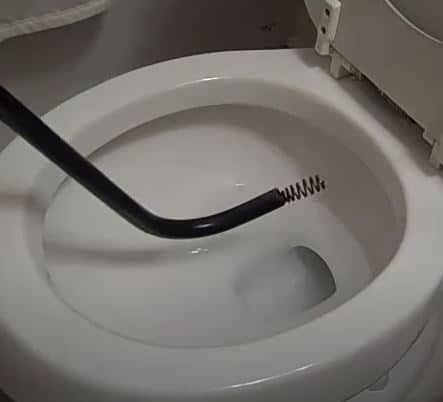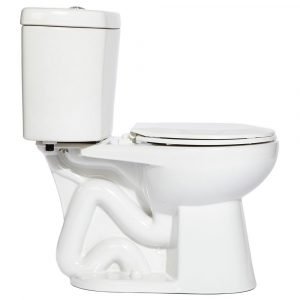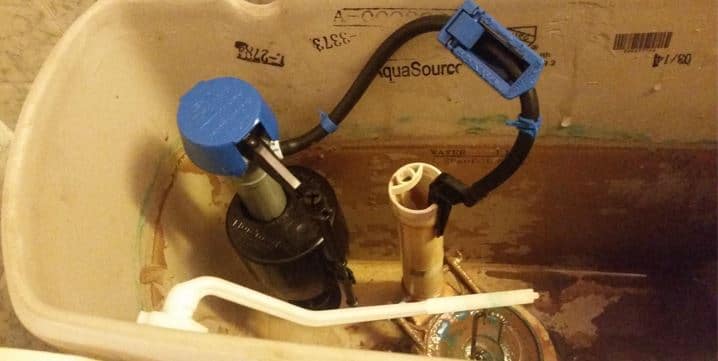Why Your Toilet Keeps Clogging and How to Fix It
Last Updated on August 1, 2023 by toilethaven
Why Does My Toilet Keep Clogging?
A toilet that constantly gets clogged can be very frustrating. It could also be a very expensive fixture if you have to call in a plumber every time it clogs.
Some toilets get clogged more often than others. Others don’t clog at all. But what makes a toilet clog so frequently?
If your toilet keeps clogging, you have a solid partial clog in the toilet trap or drainpipe, creating a restriction. It could also be caused by flushing something you shouldn’t, a low water level in the tank, or a toilet flapper that is not opening all the way.
There are many reasons why you could have a constantly clogged toilet. In brief, the reason your toilet keeps clogging is:
- A clogged toilet trap or drain line
- The toilet flapper won’t open all the way
- The low water level in the tank
- You have a first-generation low-flow toilet
- The vent stack is clogged
- A family member has chronic constipation
- Weak flushing toilet
For a toilet to flush correctly without clogging, a large quantity of water must be dumped in the bowl within the shortest time possible. This creates the siphoning effect in the toilet trap, causing the waste to be siphoned into the drainpipe.
If you have a slow-flushing toilet, partially clogged toilet trap or drainpipe, clogged sewer lines, or even a blocked vent stuck, your toilet will most likely be every time you flush it.
To fix a toilet that keeps on clogging:
- Use an auger to remove the clog
- Unclog the vent stack
- Adjust the flapper chain length
- Only flush down toilet paper
- Avoid using too much toilet paper
- Adjust the water level in the tank
How to Fix a Toilet that Keeps on Clogging

Depending on what is clogging your toilet, your approach to fixing it will be different. Let us look at these causes one by one and how to fix them
1. Don’t Flush What You Shouldn’t
The most common cause for a clogged toilet is when things that should not be flushed end up being flushed. Anything outside of human waste and toilet paper has the potential to clog your toilet unless it’s in liquid form. Too much toilet paper usage will also clog a toilet.
From experience, here are some of the things that are responsible for clogging toilets most of the time:
- Baby diapers
- Toothbrushes
- Toys
- Baby wipes
- Hand towels
- Tampons and Pads
- Condoms
- Dental floss
- Paper towel
- broken glasses
These things mostly clog toilets in a house with many family members instead of one or two people in a home. What can you do to make sure that things that are not supposed to be flushed stay away from the toilet bowl?
Having a conversation with all family members explaining what should not be flushed will go a long way in preventing a constantly clogged toilet. Also, put in a trash can in the bathroom for disposing of such things as tampons and baby wipes.
2. Unclog the Toilet Drain
A toilet trap is the S-shaped part of the toilet between the bowl and the drainpipe. It is S-shaped for 2 reasons. It acts as an anti-clog mechanism to prevent items that fall in the bowl from clogging the drain further down.

Secondly, it holds a small amount of water that prevents unpleasant sewer gases from entering your bathroom. Due to that design, most of the things that fall in the bowl can be removed, and if flushed, clogs the toilet at the trap.
When your trap is fully clogged, it will not drain water, and the toilet may overflow. A partially clogged toilet trap will drain the water slowly but will not flush properly.
Diagnosing and fixing a fully clogged toilet is easier than a partially clogged one. If a toothbrush or pen is stuck in the trap, you will keep plunging your toilet, which will only give a temporary solution before it starts clogging again.
The simplest way o clearing a toilet is by plunging it. If a plunger does not work, get a toilet auger and snake the toilet. A toilet auger will pull out items, unlike a plunger which pushes everything down the drain.
Mineral deposits as a result of hard water could also build up inside your toilet trap. Calcium is the most notorious one. This will reduce the internal diameter of the trap, and there be prone to constant clogging.
If you suspect this is the problem, you can easily remove your toilet, lay it on its side, and check the trap’s condition. It is always easy to check from the bottom of the toilet. Here is how to remove a toilet.
3. Have Chronic Constipation Treated
Some people suffer chronic constipation from quite a young age. In most families, such members are said to be “chronic toilet cloggers.” It can be quite an uncomfortable condition to live with, knowing you are most likely to clog every time you use the toilet.
According to Healthline, Chronic constipation results from the large intestines overstretching, a condition known as megacolon. The large intestine, also known as the colon, therefore, holds more or a big poop which is hard and often clogs the toilet.
Drinking lots of fluids and eating food rich in fiber can go a long way in softening your poop. Visiting the bathroom as soon as you feel the urge to poop will also see you clog the toilet less and, with time, even stop.
4. Upgrade First Generation Low-Flow Toilets

Old toilets could use up to 3 gallons of water per flush. Such a large volume of water was enough to flush down everything, so the chance of clogging a toilet was low.
In a bid to conserve water and the environment, low-flow toilets, which use 1.6 gallons of water per flush or even less, were introduced. Some design aspects had to be altered for these toilets to work without clogging toilets. This includes the size of flush valves, trapway, and siphon jets.
The first-generation low-flow toilets were hit-and-miss. If you were one of the unfortunate buyers, you would ultimately need to upgrade to a modern toilet. In the meantime, you should minimize the amount of toilet paper used. Don’t also flush items that are more likely to clog your toilet.
5. Fix Slow Flushing Toilet
In order for your toilet to flush powerfully and without clogging, water has to be released from your toilet tank to the bowl within seconds. The water also has to be sufficient.
The action of releasing a large amount of water suddenly into the bowl produces powerful and non-clogging flushing. This is why modern toilets have large flush valves and tramways.
When water enters your toilet bowl slowly, the siphoning or suction effect at the toilet bowl will be weak, which will most likely clog your toilet. What causes a slow-flushing toilet?
- Clogged rim hole jets
- Loose toilet flapper lift chain
- The low water level in the toilet tank
- Clogged toilet vent
A slow-flushing toilet will also have you flushing the toilet several times before everything can leave the toilet bowl. Here is how to fix a slow-flushing toilet.
6. Unclog the Plumbing Vent

A vent stack runs from your toilet drain to the top of the roof. It allows sewer gases to flow from the drains to the outside freely. This way, the toilet’s siphoning action is stronger, and clogging is unlikely.
When you have a clogged toilet vent, air cannot flow out, and as a result, you will have a negative air pressure. In this case, the air will start backing up to the toilet. A bubbling/gurgling toilet and a sewer gas smell in the bathroom exhibit it.
To fix this issue, climb to the top of the roof using a ladder with a garden hose in hand. Have someone turn the water on and pour the water down the vent stack.
The water will unclog the vent and wash down anything that could be clogging it. A clogged vent stack can also cause a weak flushing toilet.
7. Unclog the Sewer Line
Sometimes a constantly clogged toilet extends beyond your toilet. At times the city’s sewer lines are clogged or rusted, or tree roots have grown towards the lines and bent them as a result.
You should talk to your neighbors to see if they are having the same problem. If they are in the same hole as you are, you can then jointly the relevant authorities to fix the lines.
If your neighbors do not have the same issues, then your main house drainpipe is probably the problem. You should call in a professional plumber to have a look.
Conclusion
To prevent a toilet from clogging, make sure that anything that is not toilet paper or human waste should not be flushed. Use less toilet paper or get a bidet seat. Adjust the water level in your toilet tank to about an inch below the overflow tube.
Pouring hot water down your toilet bowl occasionally also ensures that mineral deposits and grime are dissolved or washed down the drain.